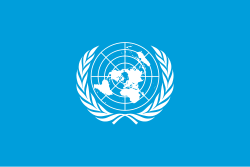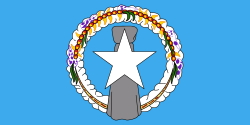 During Spanish East Indies.
During Spanish East Indies. Proposed flag for German New Guinea.
Proposed flag for German New Guinea. Flag of the Trust Territory of the Pacific Islands was used in the NMI 1965–1972
Flag of the Trust Territory of the Pacific Islands was used in the NMI 1965–1972
 | |
| Use | Civil and state flag |
|---|---|
| Proportion | 20:39 |
| Adopted | July 1, 1985 |
| Design | A circle of flowers and plants with a gray sculpture and a white star on a blue field. |

The flag of the Commonwealth of the Northern Mariana Islands was adopted in July 1, 1985 by the Second Northern Marianas Constitution. The NMI flag was originally designed during the year 1985. Later during that year, they finalized the draft of the flag in the last CNMI constitutional convention. [1]
Contents
The flag consists of three symbols: a white star representing the United States, a gray latte stone representing the Chamorro people, and a multi-colored mwarmwar (floral wreath) representing the Carolinians. The mwarmwar is made from the green ylang-ylang (langilang; Cananga odorata ), the white plumeria (flores mayo or seyúr; Plumeria alba ), the red peacock flower (angagha; Caesalpinia pulcherrima ), and the pink Pacific basil (teibwo; Ocimum tenuiflorum ). Its dark blue background represents the Pacific Ocean and the Mariana Trench. [2] [3] According to US Flags Design Website, the area is 78 inches in width and 40 inches in height.





